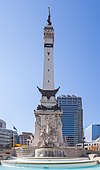
The Indiana State Soldiers and Sailors Monument is a 284 ft 6 in (86.72 m) tall neoclassical monument built on Monument Circle, a circular, brick-paved street that intersects Meridian and Market streets in the center of downtown Indianapolis, Indiana. In the years since its public dedication on May 15, 1902, the monument has become an iconic symbol of Indianapolis, the state capital of Indiana. It was added to the National Register of Historic Places on February 13, 1973 and was included in an expansion of the Indiana World War Memorial Plaza National Historic Landmark District in December 2016. It is located in the Washington Street-Monument Circle Historic District. It is also the largest outdoor memorial and the largest of its kind in Indiana.
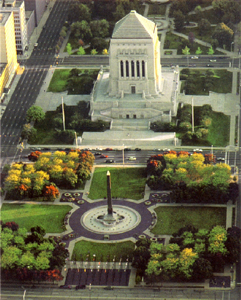
The Indiana World War Memorial Plaza is an urban feature and war memorial located in downtown Indianapolis, Indiana, United States, originally built to honor the veterans of World War I. It was conceived in 1919 as a location for the national headquarters of the American Legion and a memorial to the state's and nation's veterans.

Camp Morton was a military training ground and a Union prisoner-of-war camp in Indianapolis, Indiana, during the American Civil War. It was named for Indiana governor Oliver Morton. Prior to the war, the site served as the fairgrounds for the Indiana State Fair. During the war, Camp Morton was initially used as a military training ground. The first Union troops arrived at the camp in April 1861. After the fall of Fort Donelson and the Battle of Shiloh, the site was converted into a prisoner-of-war camp. The first Confederate prisoners arrived at Camp Morton on February 22, 1862; its last prisoners were paroled on June 12, 1865. At the conclusion of the war, the property resumed its role as the fairgrounds for the Indiana State Fair. In 1891 the property was sold and developed into a residential neighborhood known as Morton Place, a part of the Herron-Morton Place Historic District.

The Landmark for Peace is a memorial sculpture in Dr. Martin Luther King Jr. Park on the northside of Indianapolis. It honors the contributions of the slain leaders Robert F. Kennedy and Martin Luther King Jr. The memorial, which features Kennedy and King reaching out to each other, was designed and executed by Indiana artist Greg Perry. The bronze portraits were created by Indianapolis sculptor Daniel Edwards.

The Lincoln Monument of Wabash, Indiana or The Great Emancipator is a public sculpture by Charles Keck, a sculptor who was born in New York City. The cast bronze sculpture was commissioned by Wabash-native Alexander New and donated to the city of Wabash, Indiana, in 1932. It has remained on view at the northeast corner of the Wabash County Courthouse lawn ever since.

Untitled (Jazz Musicians) is an outdoor sculpture by American artist John Spaulding. It is located on the border of Indiana University-Purdue University Indianapolis (IUPUI) campus, near downtown Indianapolis, Indiana, at the corner intersection of Indiana Avenue and West Street. The sculpture faces the historic Madam Walker Legacy Center, which is located across the street.

The Thomas A. Hendricks Monument is a public artwork by American artist Richard Henry Park and is located on the southeast corner of the Indiana Statehouse grounds in Indianapolis, Indiana. The monument is a tribute to Thomas A. Hendricks, the 21st Vice President of the United States. Hendricks was a former U.S. Representative and U.S. Senator from Indiana. He was the 16th Governor of Indiana and led the campaign to build the Indiana Statehouse.
The Hildebrand Monument is a public artwork fabricated by Joyce & Diener and located at Crown Hill National Cemetery in Indianapolis, Indiana. The monument marks the graves of Henry W. Hildebrand and his three children, William H., Louisa E., and George H. Hildebrand. It features an eighteen-foot column mounted on a rectangular base made of granite with a cornice that is peaked and a tiered bottom section. On top of the cornice is a full-sized statue of Henry W. Hildebrand wearing a frockcoat. In his left hand is an anchor and his right hand is upraised in the air. Behind him is a tree stump.
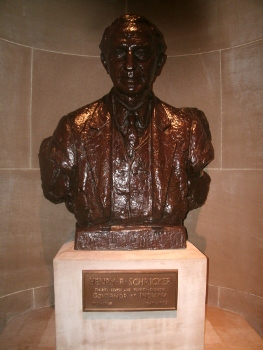
Bust of Henry F. Schricker, is a public artwork by American artist David K. Rubins, located in the Indiana State House, which is in Indianapolis, Indiana, United States. It is a bronze bust of former Indiana governor Henry F. Schricker. The bust and its base are 49 inches high, 29 inches wide, and 22 inches long. The bust itself is 33.5 inches high on a 15.5 inch high base. It was installed in the southeast alcove of the Indiana State House in 1964 and faces east.

Christopher Columbus is a public artwork by Italian artist Enrico Vittori and located on the grounds of the Indiana Statehouse in Indianapolis, Indiana. The sculpture was installed on the southwest corner of the Indiana Statehouse lawn in 1920 as a gift from Italian immigrant communities in Indiana.

William H. English is a public artwork by an unknown artist, located in a niche on the third floor of the Indiana Statehouse, which is in Indianapolis, Indiana, United States of America.

Oliver P. Morton and Reliefs is a public artwork by Austrian artist Rudolph Schwarz, located on the east side of the Indiana Statehouse in Indianapolis, Indiana, at the intersection of North Capitol Avenue and West Market Street.
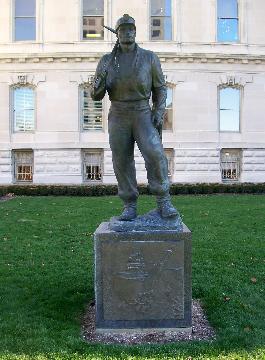
Coal Miner is a public artwork by Polish American artist John J. Szaton (1907–1966) which is located in two US State capitals; the original, commissioned in 1963 in Springfield, Illinois, as well as a copy on the west lawn of the Indiana State House in Indianapolis The statues commemorate coal miners who had lost their lives in those states' mining industry. The 7-foot (2.1 m) tall statue rests on a 3-foot (0.91 m) square, granite base supported by a cement foundation that is 4–6 inches (100–150 mm) thick.

Abraham Lincoln is a public artwork by American sculptor and medallist Thomas Dow Jones, located in the Indiana Statehouse, Indianapolis, Indiana, United States. The painted plaster bust of Abraham Lincoln that resides in the Indiana Statehouse is a copy of an 1861 clay bust. Several versions of the bust exist in plaster, marble, and bronze mediums.

Stumbling Man is an outdoor sculpture by American artist David K. Rubins (1902–1985) located on the grounds of the Indianapolis Museum of Art (IMA), which is near downtown Indianapolis, Indiana. The sculpture is cast bronze and is in the shape of a man crouched upon the ground.

Nymph and Fawn is a public artwork by American artist Isidore Konti and located within the Oldfields–Lilly House & Gardens estate on the grounds of the Indianapolis Museum of Art (IMA), near Indianapolis, Indiana. Created in 1917, the bronze sculpture is also a working fountain. It portrays a female nude pouring water from an urn while standing beside a small fawn.
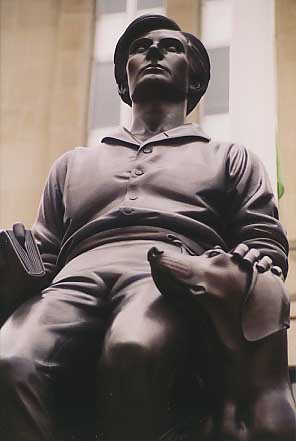
Abraham Lincoln, The Hoosier Youth is a heroic bronze sculpture by American artist Paul Manship and was commissioned in 1928 by the Lincoln National Life Insurance Company for its headquarters in Fort Wayne, Indiana. The statue is 12.5 feet (3.8 m) tall and sits atop a pedestal designed by architect Benjamin Wistar Morris and a granite base. The sculpture depicts a youthful Abraham Lincoln during the time he lived in Indiana. The Lincoln figure wears a handmade shirt, buckskin trousers, and boots. He is seated on a tree stump and holds a book. An ax leans against his leg and a dog is seated beside him. Manship also sculpted four bronze allegorical bas reliefs, one for each side of the pedestal, to represent traits associated with Lincoln: Charity, Fortitude, Justice and Patriotism. The statue was dedicated on 16 September 1932.
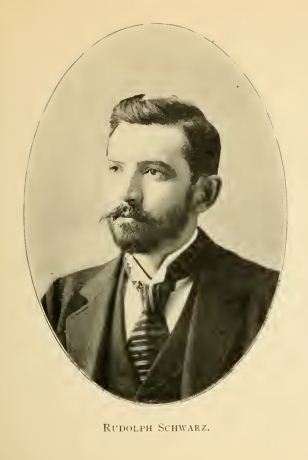
Rudolf Schwarz, sometimes spelled Rudolph Schwarz, was an Austrian-born American sculptor. He emigrated to Indianapolis in December 1897 to help complete the Soldiers' and Sailors' Monument in Indianapolis, Indiana, which was designed by German architect Bruno Schmitz. He was invited to work on the project by Karl Bitter, with whom he had worked in Austria.

The Soldiers and Sailors Monument is a work of public art in Delphi, Indiana in the United States. It is located at the Carroll County Courthouse, and comprises the collection on the National Register of Historic Places listing making up the courthouse and the square.


















